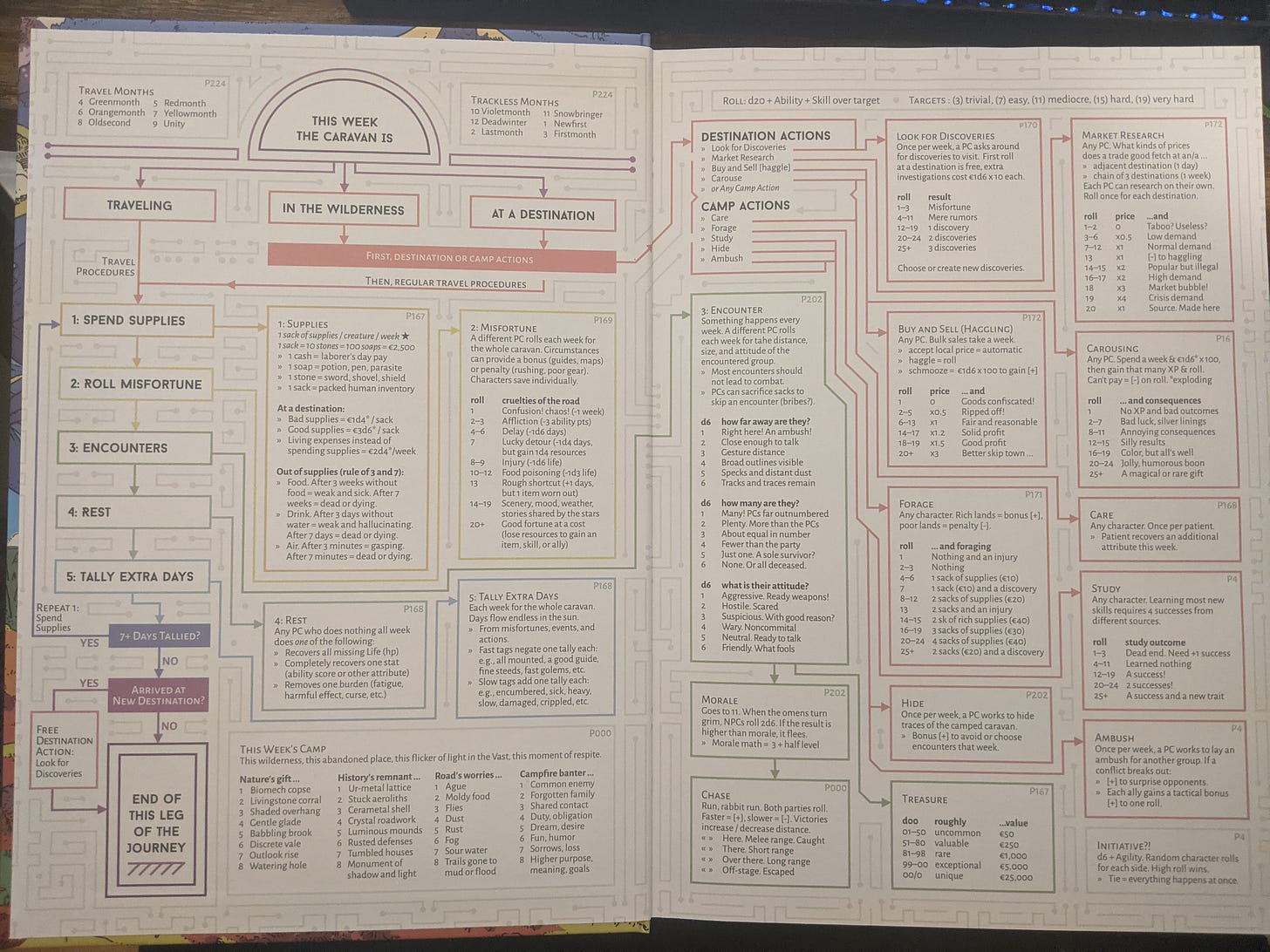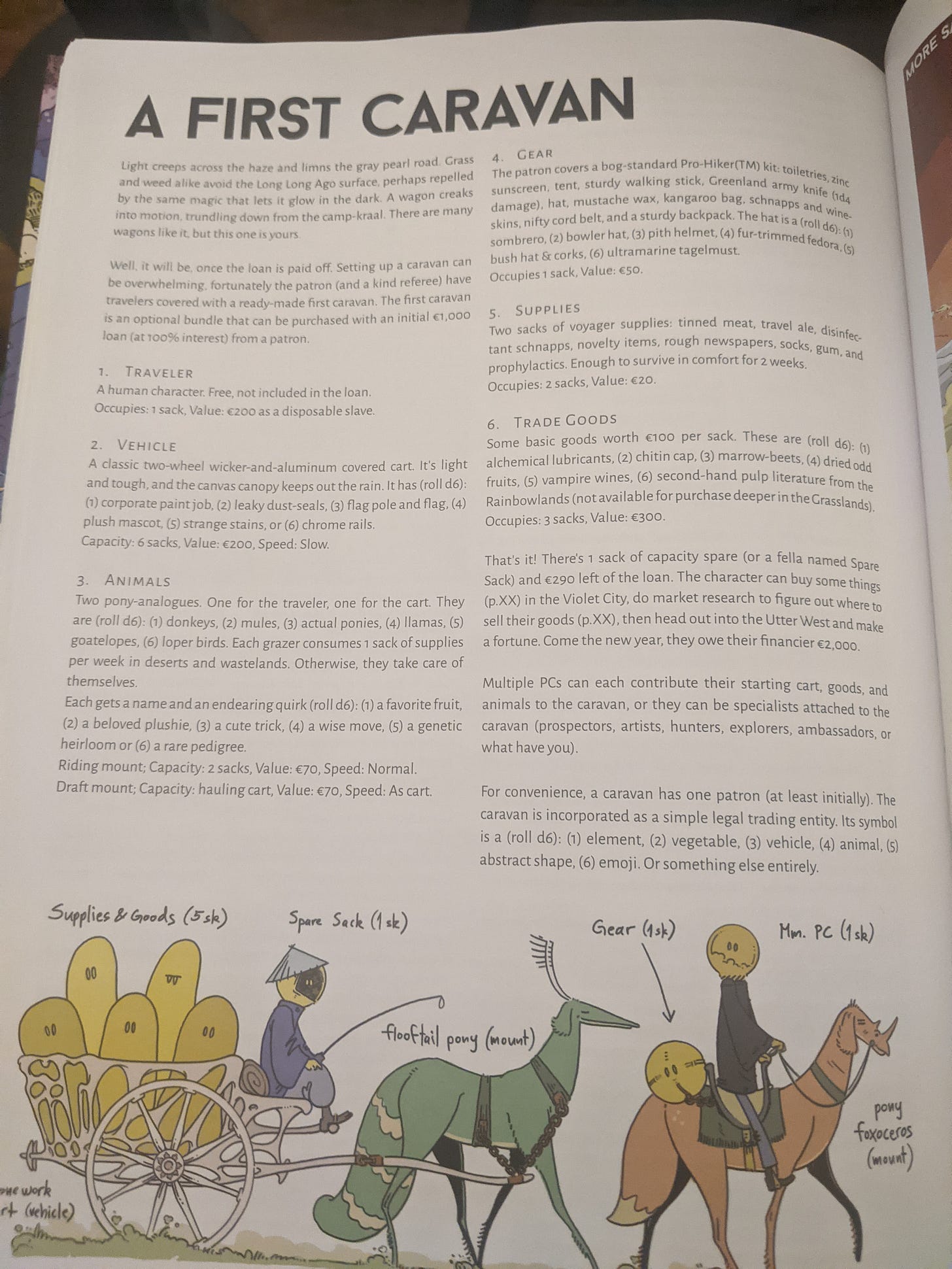Ultraviolet Grasslands 2E is out.
I somewhat apologetically love Ultraviolet Grasslands, in the way that one might apologetically love B-movies, or Tech N9ne, or the Philadelphia 76ers (all other things I love, to be clear). Despite its flaws, and there are many, there are flashes of such brilliance and such fun that I cannot help but keep coming back to it for inspirational fodder over and over again. Perhaps its the Blue Oyster Cult lyrics in the frontpages, or perhaps the Captain Star reference in the locations, but like B-movies, or the Sixers, or Tech N9ne, there’s a level of enthusiasm and sheer joy for the medium that lets me gloss over the bloat, the vagueness, and even the bullet points.
UVG2E is Big.
Like, really big. The first edition I have clocks at 198 pages, and for a book whose chief issue I take with it is superfluous nontent, 198 pages is A Lot. 2E comes in from the top rope at 246 pages. Much of that is a result of a new layout scheme giving way for more art (more on this later) but there is a deal more of both mechanical quality of life improvements in the SEACAT system and just more Things included. For example, these handy flowcharts to better explain the structure of intended play:
There is A Lot of information here, all of which I’d categorize as both Useful and Good: UVG’s somewhat odd units of measurement (cash/soap/stone/sack) is explained in easier to understand terms, the carousing and market research elements of character advancement and caravan play are broken down into more digestible paragraphs, and there’s even encounter distances/numbers/reactions AND morale rules included. UVG1E’s layout makes for excellent reading from location to location but the actual rules of SEACAT are not at all arranged in an accessible manner, so this is a step in a good direction, in my opinion. Will I ever actually use SEACAT? Probably not, I already have Traveler, but I will continue to borrow bits and bobs from it.
Like 1E, 2E has a “who is this hero?” section immediately prior to any of the locations that offers both too much and not enough information on… making a hero. Don’t get me wrong - I love the chunky d50 “who/why/what” table, I love the flavorful names, I love the quirks - 2E adds even more to the Making A Guy part to help get into the proper headspace, flinging in-universe terms and ideas at you with no explanation. This is a bold choice and I strongly believe more TTRPGs with a built-in “default” setting should explain aspects of that setting less. That there is a glossary of terms in the back section of 1E I will always consider as an act of cowardice. Its like The Force: it should be a thing that is; the moment you add Midichlorians into the mixture I tune out.
Much to the same degree that Midichlorians are mentioned in passing but their significance never explained in a satisfying manner, character generation in UVG starts in the frontpages with some brief aesthetics and then… isn’t returned to until AFTER all of the locations are detailed. One of the worst sins in a TTRPG book, in my opinion, is excessive page-flipping. If I wanted to read the book I would (and do!) do that. I don’t want to have to read the book at the table except to reference something quickly and get back to the act of play at hand. I certainly shouldn’t have to flip from the beginning to the end of the book and back again to create a character. Have it all at the front, or all at the back.
The locations themselves are (thus far - I haven’t done a 1:1 comparison of all of them yet) the same, or at least so similar as to be unnoticable at a skim. There is definitely more Art, but I’m not sure how useful that is in play. It makes for a… well, it makes for more art. It isn’t particularly more readable as a play aide, and it isn’t particularly more readable as a Book. My opinions on art in TTRPG books borders on the heretical but I believe it should still serve some purpose, no? This seems to me like a Business Decision, which I can hardly fault. Art sells books.
‘A First Caravan’ is a very Good section. Having run through UVG multiple times with multiple systems/rules/groups this is always the part that my groups have stumbled with and has required the greatest amount of eliding of the text. Laying out caravan creation in more straightforward terms is just… a lot better. Ditto with expansions to sample beasts of burden, transportation devices, and services.
Of special interest to me is the Bestiary. One of my biggest gripes with UVG1E is that while “marmotfolk, L1, foraging” is perfectly reasonable shorthand for an adventure module encounter, having no foundation whatsoever to extrapolate from that makes for some potentially very boring encounters without a lot of legwork done prior to encountering anything. Creature special abilities, suggested loot, appearances, wants, needs - all good things. I could even do with less of the descriptions to keep the aura of mystique and surrealism present, but I need something more than what was given in the first edition.
Much as I did and do with UVG1E, I have mixed feelings overall with 2E. I bought it - obviously, and the accompanying map, and the GM screen, and I have two sets of dice, and I have two different copies of the UVG1E book, so - obviously I am invested. I think overall the location listings in the first edition are significantly better laid-out, easier to read during play and less cluttered with art that, while great and all, doesn’t help me actually use this book any better and in fact makes it more difficult in places. Which is very strange, because I would consider the non-location sections of the book - the SEACAT rules, the caravan rules, the bestiary - all to be significant upgrades over 1E’s fast-and-loose approach. In both editions, there is either too much explanation or not enough, and there’s no in-between. That much at least has not changed.
There is so much here that requires taking an editor’s chainsaw to, and this is coming from someone who freely admits a predilection to the verbose. Brevity is difficult, and I understand the impulse to double and triple down; more content, more weirdness, more words. Like art, the idea of “content” in a TTRPG book is one designed specifically with the marketplace in mind. Brevity is the enemy here - it literally sells better to go with More, to go Bigger, to do the deluxe hardcover, to pack it with Art, to pack it with more Sections, to grant the illusion of value for your $50 USD Product. And I am not immune to it any more than anyone else is. Did I mention I have three copies of this book in various editions and covers?
And this has always been my issue with The Ultraviolet Grasslands. They really and truly do stretch on and on, for far longer than they need to. I both love and loathe the self-indulgence of these books, the reckless disregard for editing, for accessibility, for useability. But at the same time I find it just does not lean into it enough. Not every TTRPG tome deserves say, Zedeck Siew’s razor-sharp incisiveness, where not a single word is unnecessary. But UVG tries to have its cake and eat it too, tries to cut the main course short and then lingers too long on cognac afterwards. Do you want maximum artistic hedonism? Then do that! Where and how corners are cut seems borderline nonsensical, and where prose rambles on past the point equally so.
Ultimately this, like UVG1E, are books that long to be cut to pieces, chopped & screwed and re-arranged and re-organized and repurposed into the collected loose-leaf notes of a GM binder, to be pulled out and smoothly interjected into a Something Else. The flashes of brilliance really are quite brilliant - there’s a reason I keep coming back. But like fly fishing or gold panning, the labor required to sift through the excess, joyful as it may be, rewarding as it may be, is not insubstantial. And like other, similar tomes of excess - Silent Titans and Electric Bastionland come to mind - I’ll keep coming back for that gleam of gold. But when I speak to other people who have bounced hard off Ultraviolet Grasslands, much like they might’ve bounced off of Deep Blue Sea, or Everready, or the Sixers; when they say “I just couldn’t get into it?”
I get it. I still love it, but I get it.






